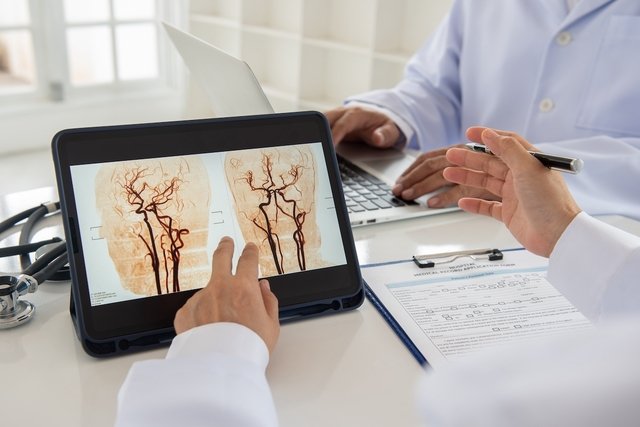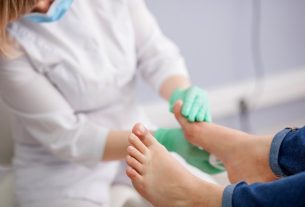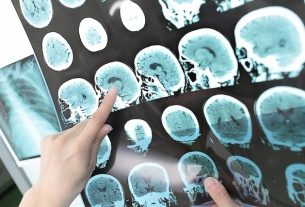Stroke is a serious condition in which the supply of blood and oxygen to the brain is interrupted or reduced, resulting in symptoms such as sudden headache, paralysis and tingling on one side of the body or mental confusion.
A stroke, also known as a stroke, can occur due to an obstruction of a blood vessel in the brain, called an ischemic stroke, or due to the rupture of a blood vessel in the brain, known as a hemorrhagic stroke.
If you suspect a stroke, you should seek the nearest emergency room immediately, as it is a medical emergency, and thus the type of stroke can be identified and the most appropriate treatment carried out, in order to avoid sequelae.

Stroke symptoms
The main symptoms of stroke are:
- Sudden headache;
- Weakness, tingling or numbness in the arm or leg, on only one side of the body;
- Loss of strength on one side of the body;
- Crooked mouth and asymmetrical face;
- Difficulty speaking clearly and understanding simple instructions;
- Blurred or double vision;
- Sudden mental confusion;
- Dizziness and loss of balance.
Furthermore, other symptoms that may appear are nausea, vomiting, memory loss, drowsiness, or even loss of consciousness.
Read too: 12 stroke symptoms (and what to do)
If you have stroke symptoms, you should immediately go to the hospital or call an ambulance by dialing 192, as it is a serious condition that needs to be treated as quickly as possible.
Don’t ignore your symptoms!
If you suspect a stroke, you should take the SAMU test, which consists of:
- S (smile): ask the person to smile. The person with a stroke has a crooked smile and mouth;
- A (hug): asking for a hug, making it possible to check whether the person has difficulty moving or lifting an arm;
- M (music): asking the person to sing a song, whereas in stroke it is difficult to sing and speak or speech may be slurred;
- U (urgent): when observing that the person has a stroke, you should urgently call SAMU, at number 192.
Until the ambulance arrives, the person should be placed on their side in a safe place, carefully observing whether the person is breathing normally. See what first aid for stroke should be like.
How to confirm the diagnosis
The diagnosis of stroke is made in the hospital by the general practitioner or neurologist, through evaluation of symptoms, physical and neurological examination, and blood tests.
To check the affected area of the brain and identify the type of stroke, the doctor must request an MRI or CT scan of the brain, making it possible to see in detail regions of bleeding or damage caused by ischemia.
Types of stroke
The main types of stroke include:
1. Hemorrhagic stroke
Hemorrhagic stroke occurs when a vessel in the brain ruptures or blood leaks from the blood vessel, resulting in a cerebral hemorrhage.
This type of stroke is generally caused by uncontrolled high blood pressure, excessive use of anticoagulants, aneurysm and head trauma, for example. See other causes of hemorrhagic stroke.
2. Ischemic stroke
Ischemic stroke occurs when a blood clot clogs a cerebral blood vessel due to a clot or thrombus, resulting in an interruption or decrease in the supply of oxygen to the brain.
This type of stroke is usually caused by uncontrolled high blood pressure or atherosclerosis, for example.
3. Transient ischemic attack
Transient ischemic attack (TIA), also called mini-stroke or transient stroke, which occurs due to temporary interruption of blood flow and oxygen to the brain.
This type of mini-stroke results in symptoms similar to a stroke, but they are more intense for a few minutes, and disappear completely within about 1 hour after the onset. Understand better what a transient ischemic attack is.
Read too: How to differentiate between types of stroke
Possible causes
The main causes of stroke are:
- Uncontrolled high blood pressure;
- High cholesterol or atherosclerosis;
- Heart diseases, such as atrial fibrillation or arrhythmia;
- Sickle cell anemia;
- Aneurysm or brain trauma;
- Diabetes;
- Use of oral contraceptives or anticoagulant medications.
Furthermore, some lifestyle habits, such as a sedentary lifestyle, a high-fat diet, smoking, excessive and frequent consumption of alcoholic beverages or drug use, can increase the risk of a stroke. Check out other causes of stroke.
How the treatment is carried out
Stroke treatment is carried out in the hospital by a general practitioner or neurologist, and varies according to the type of stroke, including medications, thrombolysis, brain catheterization, hemostatic therapy and surgery.
1. Medicines
Treatment is with antihypertensive or antifibrinolytic medications, with the aim of controlling high blood pressure, especially in cases of hemorrhagic stroke, to prevent worsening of bleeding and an increase in intracranial pressure.
Other medications that may also be prescribed by the doctor in cases of hemorrhagic stroke are mannitol, to control intracranial pressure, and anticonvulsants, to treat seizures.
Furthermore, in cases of ischemic stroke, the doctor may prescribe anticoagulant medications, such as ASA and clopidogrel, to prevent the clot from growing in the vessels and help the body eliminate it.
2. Brain catheterization
In some cases of ischemic stroke, cerebral catheterization may be indicated. This procedure, when indicated, must be done within the first 6 to 16 hours after the onset of symptoms, and consists of inserting a catheter, which is a thin, flexible tube, through an artery in the groin to reach the obstructed vessel in the groin. brain, helping to remove the clot.
Read too: Brain catheterization: what it is, what it is for and possible risks
3. Thrombolysis
Thrombolysis is a treatment that may be indicated for ischemic stroke, and is normally performed within the first 4.5 hours after the onset of symptoms. This treatment involves the use of medications, such as alteplase and tenecteplase, which are administered directly into the vein to dissolve the clot that is blocking the brain vessel.
4. Surgery
Surgery can be recommended for the treatment of hemorrhagic stroke, and can be done by removing the hematoma formed by bleeding, being indicated especially in more serious cases and heavy bleeding.
The types of surgery that may be indicated for the treatment of hemorrhagic stroke include craniotomy, decompressive craniectomy, stereotactic aspiration, endoscopic aspiration and catheter aspiration.
5. Hemostatic therapy
Hemostatic therapy is a treatment indicated to correct problems in blood clotting through the use of vitamin K, fresh frozen plasma and platelet transfusion, for example, and may be indicated to prevent worsening of bleeding in cases of hemorrhagic stroke.
What is recovery like?
Stroke recovery varies from person to person, according to the damage to the brain and the region of the brain affected, and rehabilitation is normally recommended to speed up recovery and reduce sequelae.
Therefore, rehabilitation after stroke involves a physiotherapist, speech therapy or occupational therapy, for example, to improve the person’s quality of life and avoid permanent damage. See how physiotherapy for stroke is performed.
Possible sequelae of stroke
Stroke can cause consequences such as:
- Difficulty speaking or swallowing food;
- Loss of motor coordination;
- Difficulty with reasoning and memory;
- Lack of balance;
- Decreased sensitivity in parts of the body;
- Difficulty moving parts of the body, such as arms and legs.
Furthermore, the risk of sequelae tends to be greater when there is a delay in identifying and starting stroke treatment. Understand better about the consequences of stroke.

Sign up for our newsletter and stay up to date with exclusive news
that can transform your routine!
Warning: Undefined array key "title" in /home/storelat/public_html/wp-content/plugins/link-whisper-premium/templates/frontend/related-posts.php on line 12
Warning: Undefined array key "title_tag" in /home/storelat/public_html/wp-content/plugins/link-whisper-premium/templates/frontend/related-posts.php on line 13



